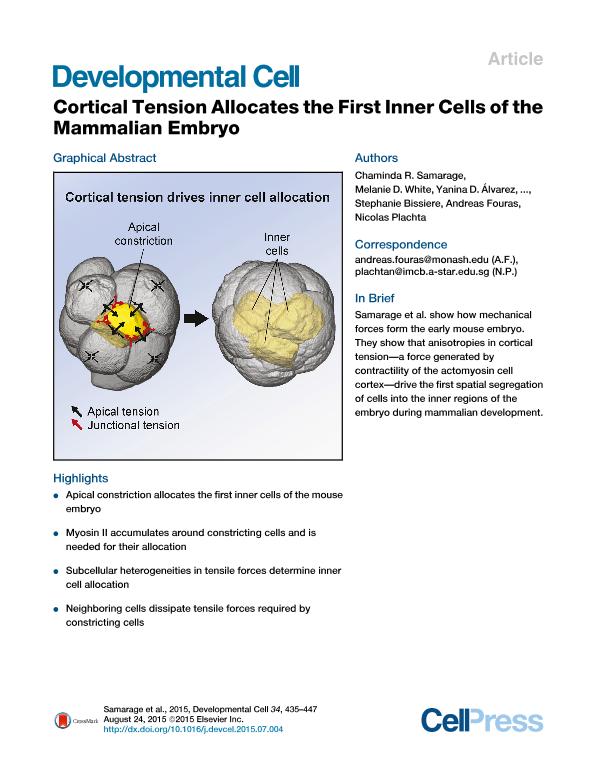Mostrar el registro sencillo del ítem
dc.contributor.author
Samarage, Chaminda R.
dc.contributor.author
White, Melanie D.
dc.contributor.author
Alvarez, Yanina Daniela

dc.contributor.author
Fierro González, Juan Carlos
dc.contributor.author
Henon, Yann
dc.contributor.author
Jesudason, Edwin C.
dc.contributor.author
Bissiere, Stephanie
dc.contributor.author
Fouras, Andreas
dc.contributor.author
Plachta, Nicolas
dc.date.available
2018-09-13T19:18:03Z
dc.date.issued
2015-08
dc.identifier.citation
Samarage, Chaminda R.; White, Melanie D.; Alvarez, Yanina Daniela; Fierro González, Juan Carlos; Henon, Yann; et al.; Cortical Tension Allocates the First Inner Cells of the Mammalian Embryo; Cell Press; Developmental Cell; 34; 4; 8-2015; 435-447
dc.identifier.issn
1534-5807
dc.identifier.uri
http://hdl.handle.net/11336/59606
dc.description.abstract
Every cell in our body originates from the pluripotent inner mass of the embryo, yet it is unknown how biomechanical forces allocate inner cells in vivo. Here we discover subcellular heterogeneities in tensile forces, generated by actomyosin cortical networks, which drive apical constriction to position the first inner cells of living mouse embryos. Myosin II accumulates specifically around constricting cells, and its disruption dysregulates constriction and cell fate. Laser ablations of actomyosin networks reveal that constricting cells have higher cortical tension, generate tension anisotropies and morphological changes in adjacent regions of neighboring cells, and require their neighbors to coordinate their own changes in shape. Thus, tensile forces determine the first spatial segregation of cells during mammalian development. We propose that, unlike more cohesive tissues, the early embryo dissipates tensile forces required by constricting cells via their neighbors, thereby allowing confined cell repositioning without jeopardizing global architecture.
dc.format
application/pdf
dc.language.iso
eng
dc.publisher
Cell Press

dc.rights
info:eu-repo/semantics/openAccess
dc.rights.uri
https://creativecommons.org/licenses/by-nc-nd/2.5/ar/
dc.subject
Mouse Embryo Development
dc.subject
Forces in Development
dc.subject
Cortical Tension
dc.subject
Inner Cell Mass Formation
dc.subject.classification
Otras Ciencias Biológicas

dc.subject.classification
Ciencias Biológicas

dc.subject.classification
CIENCIAS NATURALES Y EXACTAS

dc.title
Cortical Tension Allocates the First Inner Cells of the Mammalian Embryo
dc.type
info:eu-repo/semantics/article
dc.type
info:ar-repo/semantics/artículo
dc.type
info:eu-repo/semantics/publishedVersion
dc.date.updated
2018-09-13T13:14:27Z
dc.journal.volume
34
dc.journal.number
4
dc.journal.pagination
435-447
dc.journal.pais
Estados Unidos

dc.description.fil
Fil: Samarage, Chaminda R.. Monash University; Australia
dc.description.fil
Fil: White, Melanie D.. Monash University; Australia
dc.description.fil
Fil: Alvarez, Yanina Daniela. Monash University; Australia. Consejo Nacional de Investigaciones Científicas y Técnicas; Argentina
dc.description.fil
Fil: Fierro González, Juan Carlos. Monash University; Australia
dc.description.fil
Fil: Henon, Yann. Monash University; Australia
dc.description.fil
Fil: Jesudason, Edwin C.. National Health Service Scotland; Reino Unido
dc.description.fil
Fil: Bissiere, Stephanie. Monash University; Australia. Institute of Molecular and Cell Biology; Singapur
dc.description.fil
Fil: Fouras, Andreas. Monash University; Australia
dc.description.fil
Fil: Plachta, Nicolas. Monash University; Australia. Institute of Molecular and Cell Biology; Singapur
dc.journal.title
Developmental Cell

dc.relation.alternativeid
info:eu-repo/semantics/altIdentifier/doi/http://dx.doi.org/10.1016/j.devcel.2015.07.004
dc.relation.alternativeid
info:eu-repo/semantics/altIdentifier/url/https://www.sciencedirect.com/science/article/pii/S1534580715004554
Archivos asociados
